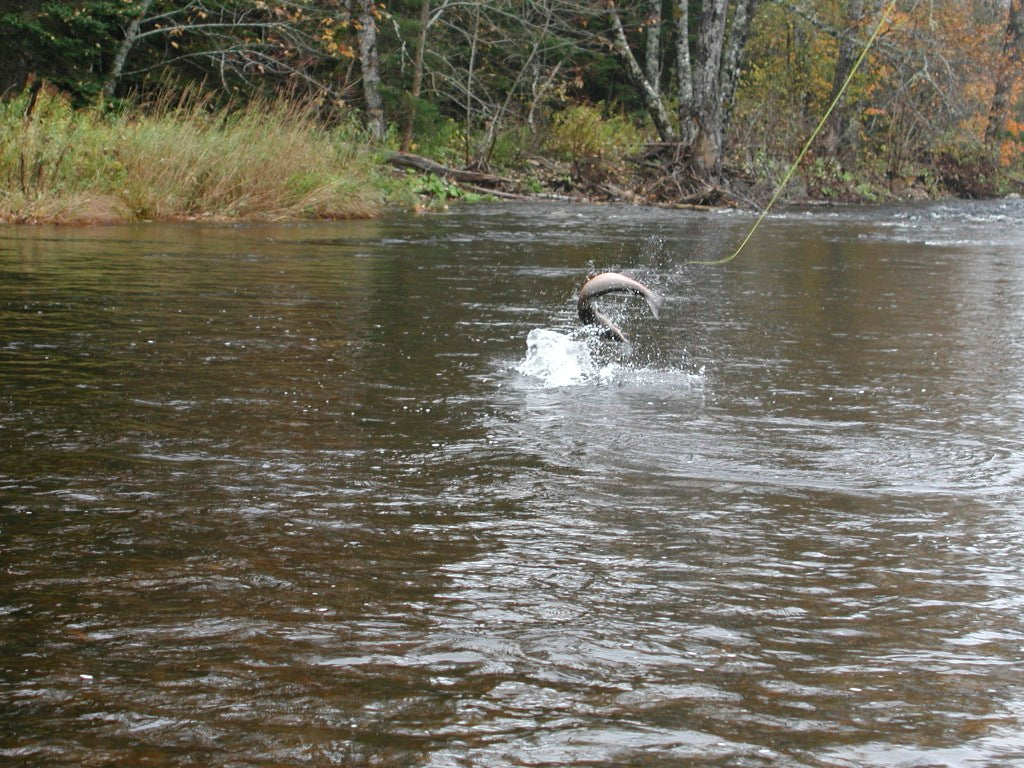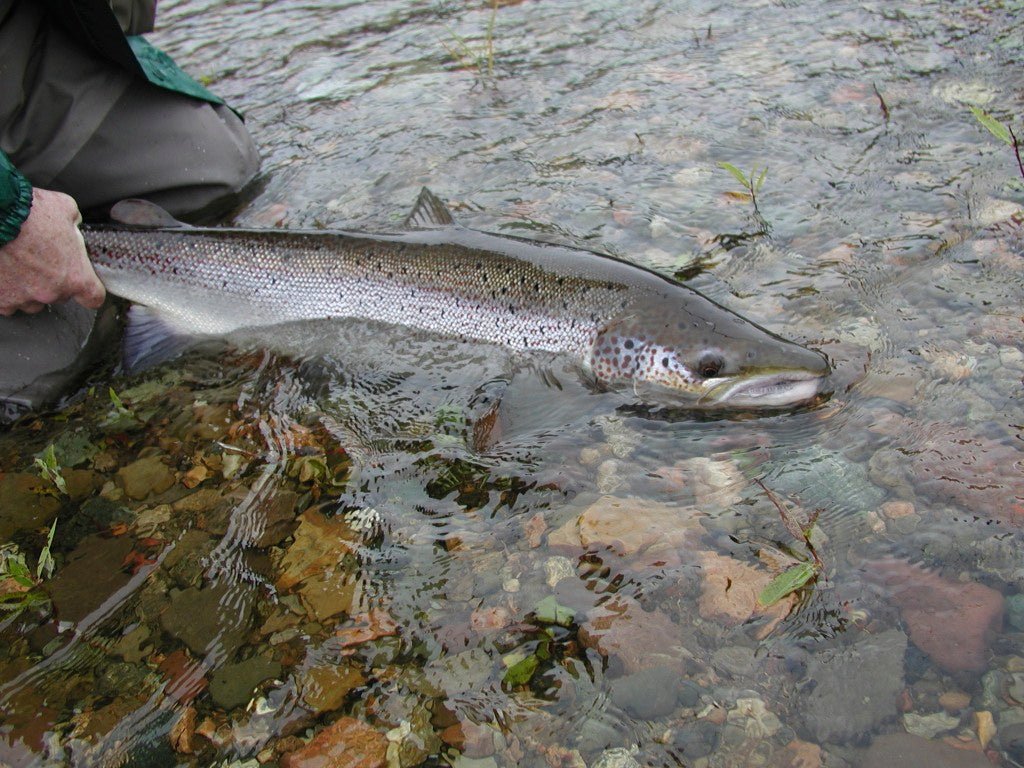Your Cart is Empty
Rods In Stock
Reels In Stock
Resources
Our Rods
One of our longstanding rod models with classic cane color and a slightly more moderate action.
One of our most recognizable rod models with a deep flamed color and crisper action.
These are our limited edition models, only released every few years.
A lot goes into crafting a bamboo fly rod and here you can learn more about our approach.
One of our longstanding rod models with classic cane color and a slightly more moderate action.
One of our most recognizable rod models with a deep flamed color and crisper action.
These are our limited edition models, only released every few years.
A lot goes into crafting a bamboo fly rod and here you can learn more about our approach.
Other Tackle

Taper Talk: Bamboo Salmon Rods
November 26, 2010 5 min read 1 Comment
I had a lot of time to think about bamboo salmon rods on my recent trip to Canada. I don’t make a ton of them these days and not because I don’t enjoy it — I do — but more for the simple reason that the demand for salmon rods is nowhere near what it is for trout rods. It’s a shame since Atlantic Salmon is arguably my favorite kind of fishing and I think more people should try it.
Anyway, those who have fished for the “fish of 10,000 casts” know that salmon fishing tends to involve a lot of down time — swinging flies through pool after pool waiting for the sudden pull — and so I found myself thinking quite a bit about bamboo salmon rod design on this last trip (one downside to fishing on vacation is that the rodmaker part of my brain tends to stay on).

I think it’s best to begin with a common misconception, namely, that bamboo salmon rods are simply trout rods on steroids. I’ve picked up on this a fair bit over the years, and in a way I can see why people think it, but the fact is that there are important design differences between the two.
One obvious difference is the taper. Most atlantic salmon fishing is done in the fall when you’re also typically fishing large flies (or perhaps in the summer throwing highly unaerodynamic bombers). Because of this you tend to need to make rods that are a little heavier tipped and a little softer in the butt section; the first helps you cast those heavier flies into tough conditions and the second helps you be a little more deliberate about it. By contrast the design for trout rods — at least those that I make — tends to be the opposite where you actually do need to do some important casting at close range, which is what a fast butt and fine tip tends to excel with. So in terms of basic taper design there’s an important difference between the two types of rods, one that’s often overlooked.
But Atlantic Salmon fishing presents a particular challenge (at least the type of fishing that’s typical of the maritimes – I can’t speak for Scandanavia, Iceland, etc.) which is that you might find yourself fishing streamers in the traditional downstream style but you might also end up casting bomber and bug dry flies as well (often having to punch them into the wind – bombers aren’t especially aerodynamic). While certain parts of the maritimes are known more for one type of fishing than another if you fish for salmon for a while you’re likely to end up doing both so you’ll need a rod with that kind of capability.
As I’ve tinkered with my own bamboo salmon rods over the years I’ve done my best to keep this in mind, and I’ve built my rods to be powerful and fast, but also capable of making rather precise, even delicate casts. While salmon don’t feed in the same way that trout do — taking flies for the purposes of food — in order to catch salmon on dries you often have to put the fly in a very small window so you just can’t turn a blind eye to precision (A few years back when Junior and I were fishing bombers on the Gaspe Peninsula— gin clear water where you can see the fish perfectly — I was amazed at how curiously fickle they could be about rising to dries. In talking with some veteran salmon fisherman in the region, they’ve really emphasized fly placement as an especially critical factor for getting the salmon off of the bottom). In short, I’ve constructed my tapers to be able to handle this sort of fishing as well.
Of course there are other issues relevant to design aside from fishing style. Bamboo salmon rods must have backbone, especially for the windier days, so that’s important. The maritimes tend to have precious few “bluebird days” where it’s calm and sunny and far more where the wind is an issue. Because of this I also prefer a rod that will load rather quickly so that I can put the fly back in the water where it belongs. Like baseball, salmon fishing is a game of percentages so those sort of things can really add up.
Furthermore, I tend to fish short rods, a fact that many people are surprised by. By short I mean in the 6’9″ to 7’9″ range, which is ideal for all but a small handful of rivers that I’ll be on. A shorter rod is easier to deal with during all of the hiking I do but it’s also just a heck of a lot more fun to fight a bright strong fish from the ocean on a rod that allows me to really feel that strength. While most of the salmon I catch are in the 9-15 lb range, I’ve also landed salmon up to 40 lbs on a 7’6″ rod. I’m not quite sure where we got the idea that we had to fish for salmon with monstrous, two-handed telephone poles, but for most places in the maritimes that’s just patently not true and shorter rods will work just fine.
Finally I also find that it’s not so tiring to use a short rod while casting, a matter which comes down to simple leverage. I find that longer rods tend to require a bit more muscle and so fishing many hours day after day means that shorter rods make more sense for me. Length also matters in that long rods inherently have to be more flexible which slows down the casting cycle, creating more “hang time” for your line, during which the wind can cause problems for you.
Ultimately, of course, whether bamboo salmon rods make sense for your angling is a personal choice. But I can certainly say that from a rodmakers perspective, a lot of thought goes into them. And of course from a fisherman’s perspective there is a lifetime of enjoyment to be had from them as well.
-Marc
PS. Below are the specific bamboo salmon rods that I offer, just to give you a sense of some of the design differences I’ve highlighted here.
| Length | Weight | Action | Notes |
|---|---|---|---|
| 6'9" | 7/8 | fast | Our favorite rod for smaller waters in the Maritime Provinces; after three years of testing, this rod has landed Atlantic Salmon up to 18 lbs |
| 7'3" | 8/9 | very fast | Designed with late fall Maritime conditions in mind; will cast very large flies with as short a stroke as possible, making it perfect for very windy weather |
| 7'6" | 7/8 | medium | Great all-around rod for medium to small pools; we've used this model for ages and it has landed hundreds of salmon including a 38-40 lb fish from Fraser pool on the Grand Cascapedia |
| 7'9" | 9/10 | fast | Designed as a compliment to the 7'3" #8/9; for bigger pools where you may need to make longer casts or shift to a #10 line when the wind is howling |
| 8' | 8 | medium-med. slow | A model that's more on the traditional side; for use on medium and smaller pools |
| 8'6" | 8-9 | medium-slow | A great caster; when delivered to a new customer, he peeled the line off the reel, made two false casts, and threw the entire line |
| 9' | 8-9 | medium-slow | A favorite of west-coast steelheaders |
1 Response
Leave a comment
Comments will be approved before showing up.











Ed Page
June 18, 2017
I have two bamboo salmon poles that belonged to my father. so, they are probably from the 1940’s or early 1950’s. I don’t fish so I want to sell them. BUT are they worth anything? I have no idea. Can you give me an estimate as to their worth. They have no reels. Thanks, ed